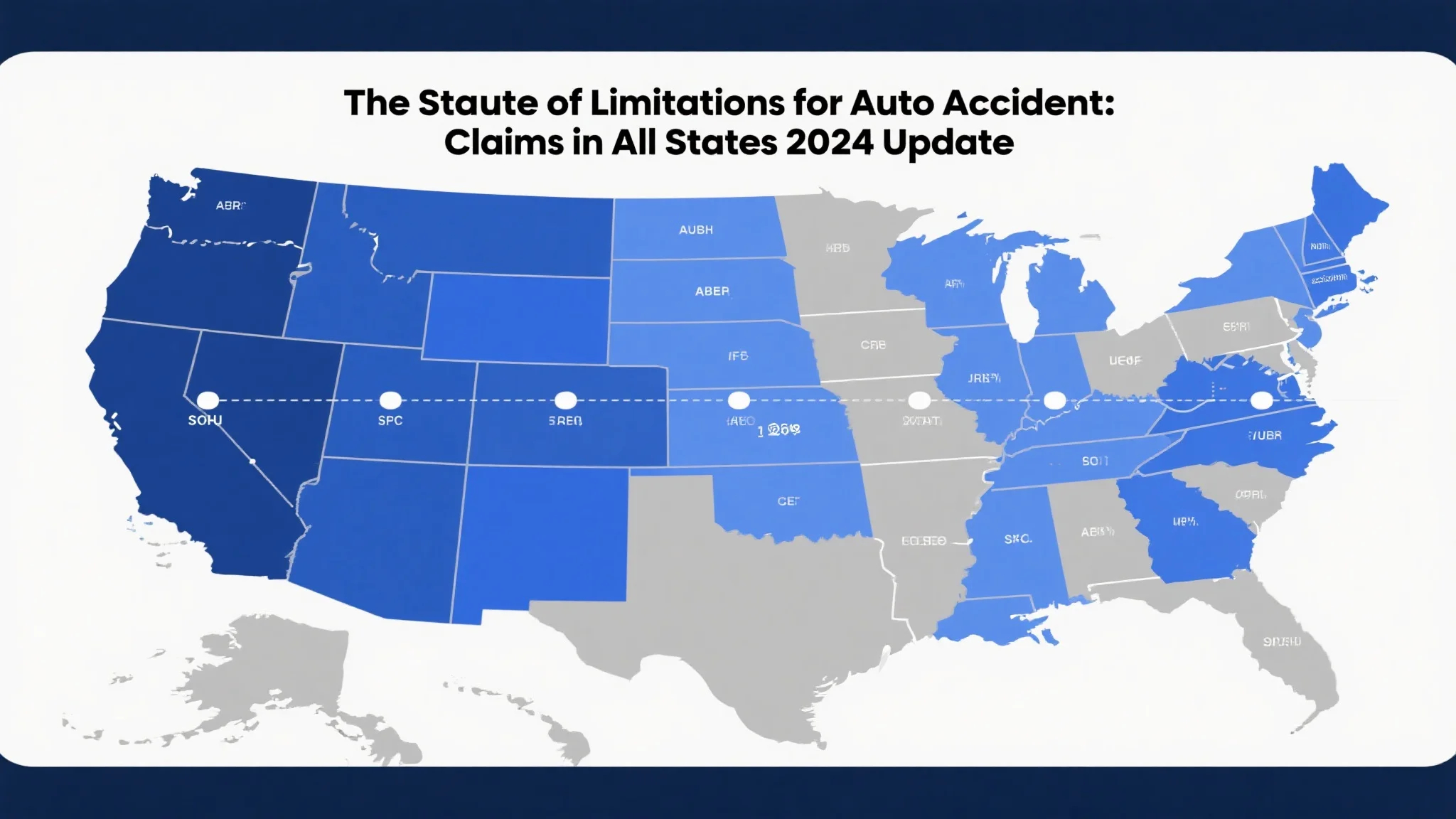Understanding the statute of limitations for auto accident claims is crucial for anyone involved in a motor vehicle collision across the United States. Each state has established specific timeframes within which victims must file their claims, and these deadlines can significantly impact your ability to recover compensation for damages, medical expenses, and other losses. The complexity of these laws varies dramatically from state to state, making it essential for accident victims to understand their rights and the time constraints they face. In this comprehensive guide, we’ll explore the auto accident claims statutes of limitations across all 50 states, providing you with the most current information as of 2024.
Understanding State-by-State Variations in Auto Accident Claim Deadlines
The legal timeframe for filing auto accident claims varies significantly across the United States, with some states allowing as little as one year while others provide up to six years for victims to pursue their cases. This variation stems from each state’s individual approach to balancing the rights of accident victims with the need for timely resolution of legal disputes. Understanding these differences is not merely academic – it can mean the difference between receiving fair compensation and losing your right to recover damages entirely.
In the northeastern United States, states like Maine, Massachusetts, and New Hampshire each maintain a three-year statute of limitations for personal injury claims arising from auto accidents. However, the specifics of how these timeframes are calculated can differ substantially. For instance, in Massachusetts, the three-year period typically begins from the date of the accident, but there are exceptions for cases involving delayed discovery of injuries or when the injured party is a minor. Maine follows a similar three-year rule but has specific provisions for wrongful death claims that may extend or modify the standard timeframe. New Hampshire’s approach includes unique considerations for cases involving uninsured motorists, which can affect when the statute begins to run.
Moving south along the Atlantic coast, states like New York, New Jersey, and Pennsylvania each have their own distinct approaches to auto accident claims deadlines. New York maintains a three-year statute of limitations for most personal injury cases, but the state’s no-fault insurance system adds layers of complexity that can affect when and how claims must be filed. The state requires that no-fault benefits be claimed within 30 days of the accident, while the three-year period applies to cases that exceed the no-fault threshold. New Jersey operates under a two-year statute of limitations for personal injury claims, but like New York, it has a no-fault system that creates additional filing requirements and deadlines that must be carefully observed.
Pennsylvania presents a particularly complex scenario due to its unique insurance system that allows drivers to choose between full tort and limited tort coverage. Under Pennsylvania law, the standard statute of limitations for auto accident personal injury claims is two years from the date of the accident. However, the type of insurance coverage selected can significantly impact what damages can be recovered and when certain claims can be filed. Those with limited tort coverage face additional restrictions on their ability to sue for pain and suffering unless their injuries meet specific severity thresholds defined by state law.
The southeastern states present their own variations in legal timeframe requirements. Florida operates under a four-year statute of limitations for personal injury claims, which is longer than many other states. However, Florida’s recent legislative changes have significantly altered the landscape for auto accident claims, particularly regarding the state’s former no-fault system. The state eliminated its Personal Injury Protection (PIP) requirements in 2024, fundamentally changing how auto accident claims are handled and potentially affecting filing deadlines and procedures.
Georgia maintains a two-year statute of limitations for auto accident personal injury claims, but the state has specific provisions for cases involving hit-and-run accidents or uninsured motorists that can extend these deadlines under certain circumstances. South Carolina follows a three-year rule, while North Carolina operates under a three-year statute with unique contributory negligence laws that can completely bar recovery if the plaintiff is found to have contributed to the accident in any way, making timely and thorough case preparation even more critical.
Texas, as the second-largest state by population, handles a significant volume of auto accident cases under its two-year statute of limitations. The state’s approach to calculating this timeframe includes specific provisions for cases involving minors, incapacitated individuals, and situations where the full extent of injuries may not be immediately apparent. Texas law also includes unique considerations for cases involving commercial vehicles, which may be subject to federal regulations that can affect filing deadlines and procedural requirements.
California, with its massive population and extensive highway system, operates under a two-year statute of limitations for auto accident personal injury claims. However, the state’s complex legal environment includes numerous exceptions and special circumstances that can affect these deadlines. For instance, claims against government entities in California must typically be filed within six months of the accident, a much shorter timeframe that catches many accident victims off guard. The state also has specific provisions for cases involving public transportation, ride-sharing services, and commercial vehicles that can create additional filing requirements and deadlines.
The mountain west and plains states each maintain their own approaches to auto accident claim deadlines. Colorado operates under a three-year statute of limitations, while neighboring states like Wyoming and Montana each have two-year deadlines. These states often deal with unique challenges related to weather-related accidents, rural emergency response times, and limited access to medical care, all of which can affect how statutes of limitations are calculated and applied in practice.
Understanding these state-by-state variations is crucial because the consequences of missing a statute of limitations deadline are severe and typically irreversible. Courts generally have no discretion to extend these deadlines once they have passed, regardless of the merits of the case or the severity of the injuries involved. This harsh reality makes it essential for accident victims to seek legal counsel promptly after an accident to ensure their rights are protected and all necessary filings are completed within the required timeframes.
Critical Factors That Affect Filing Deadlines and Legal Timeframes
The calculation of legal timeframe deadlines for auto accident claims involves numerous factors that can significantly impact when the statute of limitations begins to run and when it expires. Understanding these factors is essential for accident victims and their families, as seemingly minor details can have major implications for their ability to recover compensation. The complexity of these calculations often requires professional legal analysis to ensure that all deadlines are properly identified and met.
One of the most significant factors affecting statute of limitations calculations is the discovery rule, which applies in many states when injuries from an auto accident are not immediately apparent. Traditional statute of limitations periods typically begin running from the date of the accident itself. However, some injuries, particularly those involving soft tissue damage, traumatic brain injuries, or internal organ damage, may not manifest symptoms until days, weeks, or even months after the initial collision. In states that recognize the discovery rule, the statute of limitations may not begin until the victim discovers or reasonably should have discovered their injury and its connection to the accident.
The application of the discovery rule varies significantly among states and can be particularly complex in auto accident claims involving delayed-onset injuries. Some states apply the rule broadly, allowing the statute to begin running from the date of discovery for any injury that was not immediately apparent. Other states limit its application to specific types of injuries or require that the delay in discovery be objectively reasonable under the circumstances. Still other states reject the discovery rule entirely for auto accident cases, maintaining that the statute begins running from the date of the accident regardless of when injuries become apparent.
Age-related considerations represent another critical factor in statute of limitations calculations. When minors are involved in auto accidents, most states toll or suspend the running of the statute of limitations until the child reaches the age of majority, typically 18 years old. However, the specific rules governing these tolling provisions vary considerably among states. Some states provide that the statute begins running when the minor turns 18, giving them the full statutory period from that date. Others may begin the clock earlier, such as when the minor turns 16 or obtains a driver’s license.

Mental incapacity can also affect statute of limitations calculations in auto accident cases. When an accident victim suffers severe brain trauma or other injuries that render them mentally incapacitated, many states will toll the statute of limitations until the person regains capacity or a legal guardian is appointed to act on their behalf. The determination of mental incapacity and when it begins and ends can be complex medical and legal questions that require expert testimony and careful documentation.
The identity and status of the defendant can significantly impact filing deadlines and procedural requirements. Claims against government entities, whether municipal, county, state, or federal, typically involve much shorter notice periods and filing deadlines than claims against private parties. For example, many states require that claims against government entities be filed within 90 days to six months of the accident, far shorter than the typical two to three-year periods for private party claims. These shortened deadlines reflect the special legal protections afforded to government entities and the policy preference for prompt resolution of claims against public bodies.
Commercial vehicle accidents often involve additional complexity in determining appropriate filing deadlines. When accidents involve trucks, buses, or other commercial vehicles, multiple parties may be potentially liable, including the driver, the vehicle owner, the company that hired the driver, and various insurance carriers. Each of these potential defendants may be subject to different statute of limitations periods, and federal regulations may impose additional notice requirements and filing deadlines that must be observed to preserve claims.
Insurance-related deadlines represent a parallel set of time constraints that run alongside statute of limitations periods. Most auto insurance policies require that claims be reported promptly after an accident, typically within 24 to 72 hours. Failure to provide timely notice to insurance carriers can result in denial of coverage, even if the underlying legal claim is filed within the statute of limitations. Additionally, many states have specific deadlines for filing uninsured or underinsured motorist claims that may be shorter than the general statute of limitations for personal injury claims.
The type of damages being sought can also affect applicable deadlines. While personal injury claims typically follow the standard statute of limitations for the jurisdiction, property damage claims may be subject to different timeframes. Some states maintain separate, often shorter, statutes of limitations for property damage claims arising from auto accidents. Wrongful death claims, which arise when an auto accident results in fatalities, may also be subject to different deadlines than standard personal injury claims, and these deadlines may begin running from the date of death rather than the date of the accident.
Multi-state accidents present unique challenges in determining which state’s legal timeframe applies. When an accident occurs near state borders or involves parties from different states, conflict of laws principles may determine which state’s statute of limitations governs the claim. These determinations can be complex and may depend on factors such as where the accident occurred, where the parties reside, where the injuries were treated, and where the lawsuit is filed. The choice of applicable law can significantly impact the available time for filing claims and the procedural requirements that must be met.
Recent legislative changes across many states have also affected statute of limitations calculations for auto accident claims. Some states have extended their statutes of limitations in response to court backlogs and delays caused by the COVID-19 pandemic. Others have modified their laws to address emerging issues such as accidents involving autonomous vehicles, ride-sharing services, or electric vehicles. Staying current with these legislative changes is essential for ensuring that claims are filed within appropriate deadlines.
Protecting Your Rights and Maximizing Recovery Within Legal Deadlines
Successfully navigating the complex landscape of statute of limitations requirements for auto accident claims requires a proactive and systematic approach that begins immediately after an accident occurs. The steps taken in the hours, days, and weeks following a collision can significantly impact not only whether claims are filed within required deadlines but also the ultimate success of those claims in recovering fair compensation for victims. Understanding how to protect your rights while working within these legal constraints is essential for anyone involved in an auto accident.
Immediate documentation and evidence preservation represent the foundation of any successful auto accident claim, and these activities become even more critical when working within tight statutory deadlines. The scene of an accident contains crucial evidence that can disappear quickly due to weather, traffic, and cleanup efforts. Photographs of vehicle damage, road conditions, traffic signals, and visible injuries should be taken as soon as safely possible. Witness contact information should be collected while memories are fresh and before people leave the scene. Police reports, while not always immediately available, should be requested and reviewed as soon as they become accessible to ensure accuracy and completeness.
Medical documentation plays a crucial role in both establishing the extent of injuries and protecting against statute of limitations issues, particularly in cases where the discovery rule may apply. Seeking immediate medical attention after an accident serves multiple purposes: it ensures that injuries receive appropriate treatment, it creates a medical record linking injuries to the accident, and it establishes a timeline that can be crucial if questions arise about when injuries were discovered or should have been discovered. Even when injuries seem minor initially, obtaining medical evaluation creates important documentation that may become valuable if symptoms worsen or new problems develop.
The relationship between medical treatment and auto accident claims deadlines extends beyond initial emergency care. Ongoing medical treatment and documentation can be essential for cases involving delayed-onset injuries or conditions that worsen over time. Regular medical follow-ups, compliance with treatment recommendations, and detailed documentation of symptoms and limitations all contribute to building a strong case while also providing evidence of when injuries were discovered and how they have progressed since the accident.
Insurance notification and claim filing represent parallel processes that must be managed alongside legal deadlines. Most auto insurance policies require prompt notification of accidents, typically within 24 to 72 hours. This notification should include basic facts about the accident but should be carefully worded to avoid admissions of fault or statements that could be used against the insured later. Working with experienced legal counsel can help ensure that insurance notifications are handled appropriately while preserving all legal rights and options.
The investigation and development of auto accident claims must be conducted with an awareness of applicable legal timeframe constraints. Complex cases involving multiple parties, commercial vehicles, or government entities may require extensive investigation that can take months to complete. Starting this investigation process early ensures that all necessary evidence can be gathered and analyzed before deadlines expire. This investigation may include accident reconstruction, expert witness consultation, medical record review, and detailed analysis of insurance coverage and policy limits.
Communication with insurance companies requires careful attention to both legal deadlines and strategic considerations. Insurance adjusters often attempt to resolve claims quickly, sometimes before the full extent of injuries and damages is known. While prompt settlement can be beneficial in some cases, accepting early settlement offers can preclude future claims if additional injuries or complications develop. Understanding how settlement negotiations interact with statute of limitations deadlines is crucial for making informed decisions about when to settle and when to continue pursuing claims.
Legal representation becomes particularly important when dealing with complex statute of limitations issues or cases involving multiple potential defendants. Experienced auto accident attorneys understand the nuances of applicable deadlines in different jurisdictions and can ensure that all necessary filings are completed within required timeframes. They can also identify potential tolling provisions or exceptions that may extend deadlines in specific circumstances. Perhaps most importantly, legal counsel can help coordinate the various deadlines and requirements that may apply to a single case, ensuring that nothing falls through the cracks.
The strategic timing of legal filings requires balancing the need to meet deadlines with the desire to fully develop claims before filing. While statute of limitations deadlines are absolute, filing a lawsuit immediately after an accident may not always be the best strategy. In many cases, it may be beneficial to allow time for the full extent of injuries to become apparent, for medical treatment to progress, and for a complete investigation to be conducted. However, this must be balanced against the risk of missing deadlines or losing evidence over time.
Multi-party accidents present unique challenges in managing statute of limitations deadlines because different parties may be subject to different deadlines and procedural requirements. For example, claims against individual drivers may be subject to standard personal injury statutes of limitations, while claims against commercial entities may involve federal regulations and different deadlines. Claims against government entities typically involve much shorter notice periods. Coordinating these various requirements requires careful planning and often involves filing multiple claims or lawsuits with different deadlines.
Technology and modern case management tools can play an important role in ensuring that all deadlines are met and all requirements are satisfied. Legal professionals increasingly rely on sophisticated calendar and deadline management systems to track the numerous dates and requirements that may apply to auto accident cases. These systems can provide automated reminders and alerts to ensure that nothing is overlooked, particularly in complex cases involving multiple parties and jurisdictions.
The consequences of missing statute of limitations deadlines are severe and typically irreversible, making deadline management one of the most critical aspects of auto accident claim handling. Courts generally have no discretion to extend these deadlines once they have passed, regardless of the merits of the case or the severity of the injuries involved. This harsh reality makes it essential for accident victims to take prompt action to protect their rights and to work with qualified legal professionals who understand the complexities of applicable deadlines.
Recent developments in auto accident law, including changes related to autonomous vehicles, ride-sharing services, and evolving insurance requirements, continue to create new challenges in managing legal timeframe requirements. Staying current with these developments and understanding how they may affect specific cases is an ongoing challenge that requires continuous education and adaptation. As the legal landscape continues to evolve, the importance of working with experienced professionals who understand these changes and their implications for deadline management becomes even more critical.
Ultimately, protecting your rights within the complex framework of auto accident statute of limitations requirements requires a combination of prompt action, careful documentation, strategic planning, and professional guidance. By understanding the various factors that can affect applicable deadlines and taking appropriate steps to preserve evidence and protect legal rights, accident victims can maximize their chances of recovering fair compensation while ensuring that all legal requirements are met within the required timeframes.



